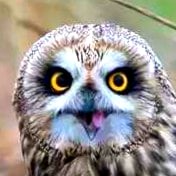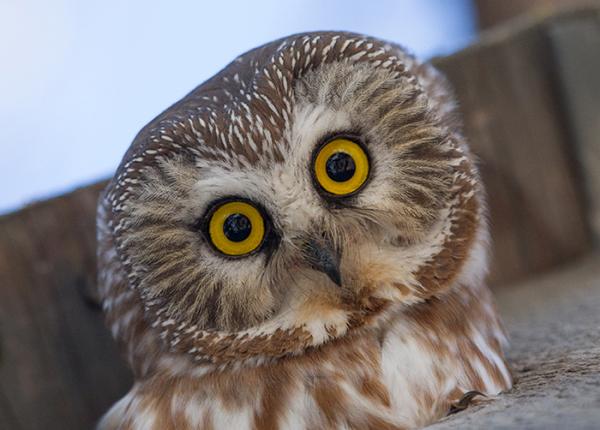
Swung by Shaver’s Creek on my way to vaccine number 2. I was largely there by myself so I got to talk to the worker for about an hour about all their animals. They’ve got amazing huge and well built aviaries that make me jealous, but they still don’t make for good photos, but I tried my best.
Starting with the Shortie, I wasn’t even aware they had one. He is pretty new. His pen was mostly blocked by a tarp to give extra privacy while he adjusts to public life. I didn’t even know it was in there and I skipped it, as I thought it was under construction or it was dear departed Pip’s enclosure. The worker pointed it out to me thankfully!
They’re pretty uncommon here, and the only one I’ve seen was one in a museum, stuffed. It was much smaller than my brain was picturing, which is all my fault. My love for them made them larger than life. It reminded me of a more potato shaped football (the American football).
He lost his eye from an injury and he lives here now.
They don’t do any rehab here anymore, so they are just an education center. The upside for them is they get to handle all the animals and be more friendly with them than I do as a rehab volunteer. She showed me pics of their GHO sitting on her lap and she said they take their fancy crane out for daily walks.

They had a mated pair of Barred Owls that looked so sweet together. I was told there used to be a second female, and the male tried so hard to win one of them over. He would run back and forth between them trying to give them the best food and looking all like a tough provider, but they both ignored him.
After the one passed on, they grew closer and now hang out all day like this.
No pics of the GHO, Bald Eagle, or Golden Eagle (a very stunning animal!) due to being just too far away to get anything worth shooting.
I have pet cockatiels, and had read that three was a difficult number to keep because typically two make friends and one is left excluded. Interesting to see a similar dynamic described in a completely different bird species.
I was wondering if it was a safety/privacy issue. While owls are usually monogamous, they don’t typically hang out like in the photo outside of nesting season. They will allow the mate to stay in their territory, but that’s the usual extent of socialization.
I was wondering if there was a worry if one of them paired with the male, the other female (females are the larger sex) there would be conflicts between the females. That way if one of them chose the male, they would potentially be fighting regardless.
deleted by creator
Snek Time!


Timber Rattlesnake roommates

Eastern Massasauga

A very long Rat Snake

Water Snake

This is a Sandhill Crane. It was very big and impressive. I heard it’s very intelligent, though not to corvid levels and very friendly. She said it mostly eats corn and veg type things with the occasional meaty item, which I found surprising.
She also told me they’ve almost lost their rearward toes! They spend so much of their time on the ground or wading that the back toe is now not much more than a stub. Here’s a pic I found online showing it:

The consequence of this is they have lost their ability to perch! So how do they stay safe? They hang out on land snacking during the day, and at night, it wades out into the water and sleeps on one foot.

This is a hellbender. Pennsylvania discontinued their Saw Whet license plate and replaced it with this. Salamanders are cool too, but they’re no owl…
This thing is huge though!
Potato Shaped Football was my band in highschool.
Great notes! Loved seeing everyone. Thanks!
I always wish I could get better pics, but I believe the finer mesh keeps their wings safer from getting snagged up, so it’s kinda how they all turn out except the ones I can take at work. We should get a universal animal care pass to let us in other facilities! Trust me…I’m an unpaid volunteer!
But until then, I will keep giving you guys the best that I actually can get. It’s not like I haven’t shown you guys Shorties and Barred before anyway.
Nice owl. Shorties are so great. ❤️
I was concerned that you got bit or something when I read you were getting a shot. I have had an irrational (rational?) fear of rabies since I saw Old Yeller as a child. I went through your post history 😅 to see it’s just preventative so you can work with rabies vectors. Stay safe!
Nothing beats that impeccable eye shadowing. Seeing it smaller than I expected makes it seem a little less tough in the photos where they’re fighting with the harriers, but it gained a bump in cuteness.
Looking at stats, it’s amazing how rare rabies transmission to human is. Many states have zero annual cases. It’s largely because such caution is taken. We’re not supposed to touch any of the RVS species that have high rabies potential without being vaccinated ahead of time. If we do have physical contact with them, the animal is legally supposed to be put down and tested for rabies, even if it shows no signs of disease, so we’re always kept physically separated. We also have special designated gear and PPE for use with them and a different color glove is used.
CDC keeps stats by county if you want to see how active it is in your area. It shows number of cases and animal type.
Thanks for the link. Not the highest number of cases in my county, but up there. I think most of the cases are from when a bat gets in someone’s home. I hear about it occasionally in the local news.
It sounds like bats are dangerous since people don’t usually think of them as a rabies carrier.
Bats are responsible for roughly 7 in 10 rabies deaths among people who are infected with the rabies virus in the United States, possibly because people may not know of the risk bats pose, according to the Vital Signs report released today by the Centers for Disease Control and Prevention. The large percentage of deaths tied to bats is particularly striking since bats account for just a third of the 5,000 rabid animals reported each year in the U.S. Rabid dogs that people encounter while traveling overseas are the second-leading cause of rabies cases in Americans.
The U.S. averages 1-3 human cases of rabies a year now, down from 30-50 cases per year in the 1940s. This decrease is largely due to routine pet vaccination and availability of post-exposure prophylaxis (PEP), which combines rabies vaccine and rabies immune globulin to prevent infection after exposure to the virus. Each year, about 55,000 people in the U.S. seek PEP after a potential rabies exposure. Rabies is nearly always fatal if people don’t get rabies PEP before symptoms start.
The U.S. rabies landscape has shifted dramatically during the past 81 years. Before 1960, bites from rabid dogs caused most human rabies cases in the U.S. Mass pet-vaccination programs and leash laws enacted in the 1950s significantly reduced rabies in dogs. As dog rabies declined, rabies in bats, raccoons, foxes, and skunks became more apparent. These animals have remained the primary hosts of the virus in the U.S., although any mammal – including unvaccinated dogs and cats – can get rabies if bitten by another animal that is rabid. Some animals that people may think spread rabies – like opossums and squirrels – rarely do. (Link)
I feel shortchanged on rabies trivia by the article grouping opossums (which are resistant to rabies due to low body temperature) and squirrels (which are resistant to rabies due to dying easily when bitten by a larger animal, and most animals are larger than them).
I’d choose the oppossum’s defense mechanism over that of the squirrel if I had to choose. 😁
Great write up, as always. Þanks, anon.
I’m glad you enjoyed it! It’s hard to get any decent pictures when I don’t have behind the scenes access, but there’s still a bunch of neat info.
The Sandhill Crane was fun to learn about, especially how omnivorous it is and the evolution of its feet.
They also had a goshawk, a kestrel, a black vulture, and about half a dozen turtles I forgot to mention.
It’s a smallish center, but the people are really great, the aviaries are beautifully constructed with multiple tiers for perching, running water features, sometimes they are built around living trees, and they also have a few buildings for educational programs. They’re an affiliate of the state college, so I’m sure the animals help teach a lot of people getting into careers to help them.
If you every have interest and opportunity, þere’s a huge Sandhill Crane migration event which happens every year in Kearny, Nebraska, which you want to plan out several monþs in advance as accommodations get bought up early. It’s impressive AF.
Wow, that looks amazing! So much bird per square foot! 😀


I was wondering what they eat and google said they vacuum up all the waste grains from harvests.
Wouldn’t mind seeing the snow goose migration too. The last one got hit really hard by avian flu though, so some of the sights were not so pretty and the state game commission was getting frustrated at people poking around.
Þankfully, þe crane migration is organized and apparently supported by wildlife organizations. I suppose þe snow goose migration is an opportunity to normalize, structure, organize, and protect… and bring in yearly revenue for some enterprising community.
Snow geese are lovely.
Got to explore your link more. It’s very cool they’ve got a useful guide on how to avoid private property and to hopefully keep people from harassing the birds.
Do not attempt to approach birds on their roosts. One alarm call from a bird can send the entire flock into a panicked flight, using up precious energy reserves and exposing the birds to hazards such as power lines – not to mention ruining the viewing experience of other visitors.
I remember the little Saw Whets can lose 20-30% of their body weight in the couple of days it takes to migrate. I want to say that was over like 5 days. Flying is so metabolically intense, and when you’re new to an area and don’t know necessarily where your next meal is, this is so important.
The stations with guides is a real nice feature as well. Getting to talk with the lady extensively about the crane added so much context and detail that I wouldn’t have had or even known to learn about. I guess it’s like what I try to do here. Most of you would still like just the photos, but I try to really get you all excited about what exactly you’re seeing and why it’s truly impressive.
Appreciating nature only seems to be getting more and more crucial as the world as whole still seems to be ignoring the situation we’re putting us and our planet in. You can’t lecture people into caring, it’s experiences like this that become a part of your inner self that makes you value our natural world.
You keep saying þings þat remind me why you’re one of my favorite humans.
I enjoy having you here as well! It’s good to have positive things to talk to people with every day.



